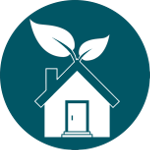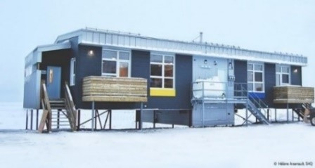Building Better Homes
Building Better Homes: Sustainable design and construction, with quality materials and flexible builds
Product of the Northern Housing Forum
Yellowknife, NT, May 2018
 BUILDING BETTER HOMES FOR SUSTAINABLE HOUSING |
Sustainable housing is “healthy, affordable, flexible and environmentally responsible housing […] that is culturally appropriate to the needs of the users.”1
 RECOMMENDATIONS |
- Explore innovative northern and cold climate housing designs. Test and pilot projects to evaluate new construction and maintenance technology to identify which cold-climate technologies are appropriate for the region.2 Work with public officials to develop appropriate building codes for northern environments. Educate occupants on maintenance and proper use to increase performance and durability of homes and ensure proper installation. Sustainable housing uses materials, technologies, and systems that are:
- – Energy efficient, durable and cold-climate appropriate (e.g. well insulated air-tight homes with efficient ventilation systems);
- – Certified for indoor and outdoor conditions identified in extreme cold climates
- – Proven performance and resilience in the North, with realistic climate conditions and occupancy loads
- – Resilient to climate change (effects of degrading permafrost, changing snow loads)
- – Mould resistant (through moisture control, adequate ventilation rate and air circulation).3
- Develop better Heat Recovery Ventilators (HRV) technology for the North (government-led or funded, as markets are small and manufactures are not incented)
- – HRV technology has not advanced fundamentally in decades, and current models are not suited for northern climates.
- Build culturally appropriate housing that reflects how residents will use their homes:
- – Engage with communities and future occupants to design housing that meets their needs (e.g. Usage of indoor spaces, adequate storage for harvested foods, seasonal clothing and equipment).
- – Ensure they are flexible (e.g. ability to move walls or add/remove small units to accommodate changes to households).
- Explore opportunities to improve cost-effective materials and construction methods:
- – Use simple, repeatable designs to allow for the re-use of standardized housing elements, designs, and workforce;
- – Ship ready-made components for rapid assembly, with trained local capacity;
- – Build year-round within a large, tempered, indoor space.
- Build prototypes to test designs and to integrate lessons learned into new construction.
- Establish communication channels between design teams and those who maintain the homes to foster continual improvement based on lived experience.
- Develop a network of key experts and organizations to facilitate knowledge sharing across northern regions to exchange lessons learned and success stories.
 CONDITIONS FOR SUCCESS |
- Learn from others: Building better homes begins by learning from others and adapting to meet local needs. Innovative design approaches, multi-plex prototypes, energy efficient materials, and improved ventilation systems are some of the best practices currently being implemented across the North.
- Ask the right questions: How is housing used and maintained? Do our designs adequately address long-term functional use by owners and occupants? Does the design fit with lifestyle and cultural needs? What space requirements are needed? What are the most cost-effective materials (not necessarily the cheapest) and designs that are most suitable for northern climates? Does housing address occupant health and wellness? What elements can we replicate elsewhere in the community?4
- Think holistically: Housing is a social determinant of health, specifically its quality, affordability, location, appropriateness and accessibility. Consider the impact of both physical characteristics of the home (plumbing, electrical [lighting], insulation) as well as social characteristics (overcrowding, proximity to schools and support services) in the planning process.5
- Form partnerships: Engaging community members and building partnerships with communities, regional organizations and colleges fosters the development of the most suitable housing options.6 When available, partnerships with northern colleges should be pursued.
 SUCCESS STORIES |
The Cold Climate Housing Research Center and the Alaska Native Tribal Health Consortium collaborated with future occupants to integrate new innovations and designs into a home in Oscarville, Alaska. They considered occupant needs and design preferences, including storage and paint colours to create a culturally appropriate home.7
EVOQ , an architectural firm with a focus on Inuit and First Nations architecture, collaborated with the Société d’habitation du Québec, Makivik Corporation, the Kativik Regional Government, and the Kativik Municipal Housing Bureau on a pilot design for social housing adapted for the northern climate and Inuit culture.8 The 2016 prototype was constructed with improved insulation to increase energy efficiency, aerodynamic features to minimize snow accumulation, and pile foundations, which are better suited to shifting permafrost. The occupants of the prototype duplex will provide feedback on future design.9
The Alaska Housing Finance Corporation administers weatherization programs and training, with over 2000 homes completed since 2008. Client education is important in this program and data is collected (pre/post) to provide case studies to construction companies10.
__________________________
- Semple, W. 2013. Best Practices in Sustainable Northern Housing. p. 90. URL: http://www.turnbackthetide.ca/files/resources/learning-from-others-report.pdf
- Nunavut Housing Corporation. 2016. Blueprint for Action.URL: https://s3.amazonaws.com/nhcweb/publications/blueprint_0.pdf
- Additional information on mould prevention is provided in the Combatting Mould best practice summary
- Wong, G. 2018. NHC 5plex MURB as a best practice in Nunavut. 2018 Northern Housing Forum, Yellowknife.
- National Collaborating Centre for Aboriginal Health. 2017. Social Determinants of Health: Housing as a Social Determinant of First Nations, Inuit and Metis Health. URL: https://www.ccnsa-nccah.ca/495/Housing_as_a_social_determinant_for_First_Nations,_Inuit,_and_M%C3%A9tis_health.nccah?id=20.
- National Collaborating Centre for Aboriginal Health. 2017. Social Determinants of Health: Housing as a Social Determinant of First Nations, Inuit and Metis Health. URL: https://www.ccnsa-nccah.ca/495/Housing_as_a_social_determinant_for_First_Nations,_Inuit,_and_M%C3%A9tis_health.nccah?id=20.
- ANTHC. 2017. Holistic approach enhances community planning in rural Alaska. URL: https://anthc.org/news/holistic-approach-enhances-community-planning-in-rural-alaska
- EVOQ. 2016. Social Housing in Nunavik: Construction of the Pilot Project Completed. URL: http://evoqarchitecture.com/en/social-housing-in-nunavik-construction-of-the-pilot-project-completed/.
- Lowrie, M. 2016. Quebec social housing agency to test unit better adapted to northern culture. CBC, 3 January 2016. URL: http://www.cbc.ca/news/canada/montreal/quebec-social-housing-agency-to-test-unit-better-adapted-to-northern-culture-1.3387630.
- https://www.ahfc.us/

